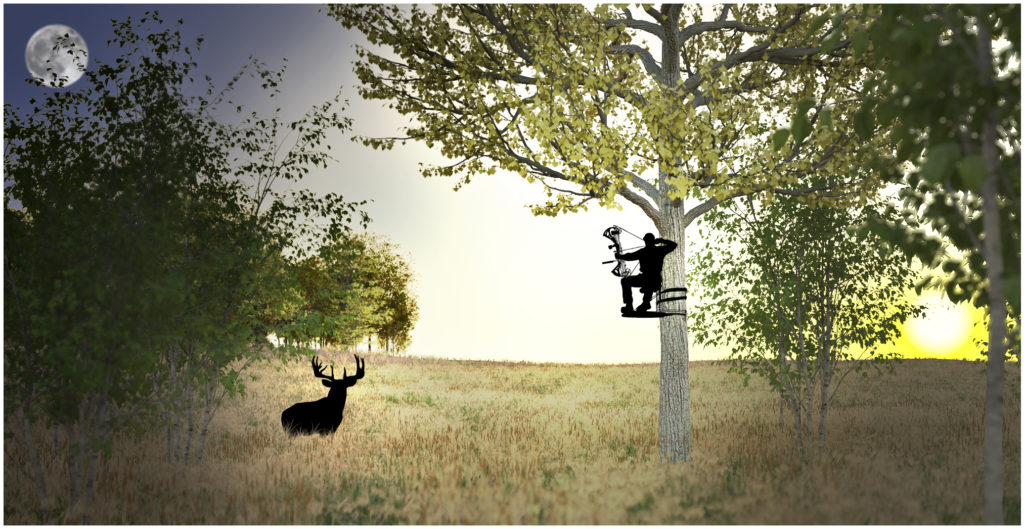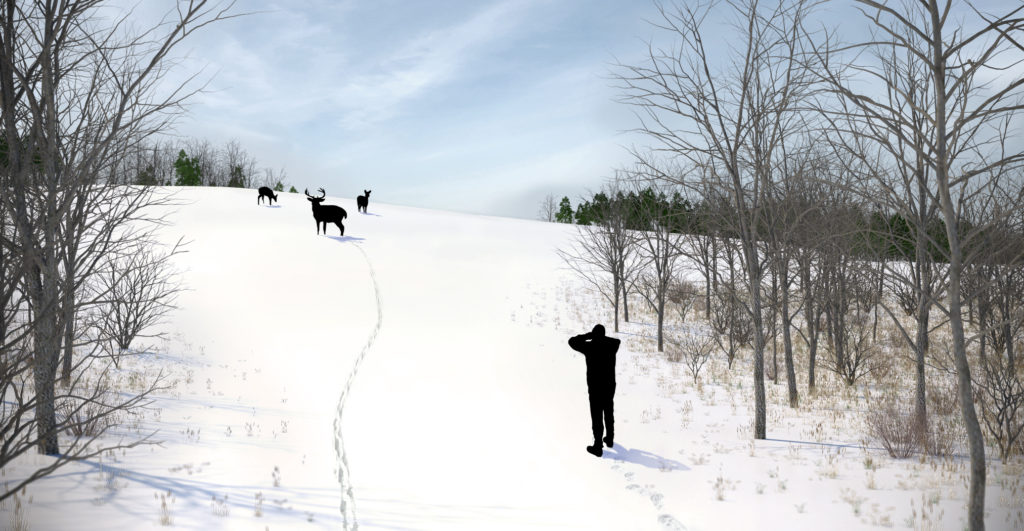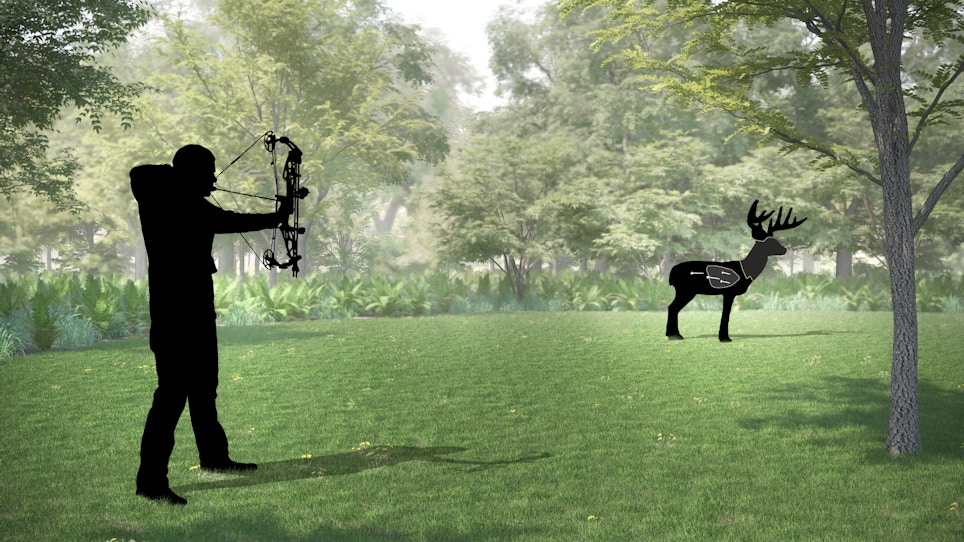If you’re serious about tagging a 170-inch-plus buck next season, then you must know the daunting odds you face. The good news is that the odds of killing a record-book whitetail today are higher than they’ve ever been. And while those odds remain extremely low for all hunters, they’re especially low for those who bumble to their traditional stand each season and hope for the best. This is good news for bowhunters. Fact is, there are ways to substantially increase your chances of taking a Booner this season. Follow these 12 “lucky” tips to maximize them.
12. Hunt funnels
During the pre-rut, most of the mature bucks have spread out into their separate core areas, where they spend most of the daylight hours napping, browsing and hiding in solitude. However, most of the deer in a small ecosystem feed on the same food sources, and they must often travel to get there. Your odds of killing a big buck can be greatly increased if you hunt corridors of cover that consolidate deer from larger areas to smaller areas of travel where you can ambush them. Identify these funnels on a map, then scout. If you find a great funnel, consider placing two stands on opposite edges of it, so you can hunt it in varying winds. For the very best odds, find a funnel near a creek bed for easy access.
11. Do something different
We’ve all heard the definition of insanity — doing the same thing repeatedly but expecting different results — so if you aren’t feeling confident in your go-to setup, try something else. Bucks live in the woods, and they can sense hunters’ movements, especially if the place has been hunted heavily. Occasionally, pull a Crazy Ivan and sneak into that little patch of woods by the front gate where no one ever hunts because they think it’s too close to the road. Old bucks have an uncanny ability to go where people don’t, so don’t be afraid to get weird if the wind is right.
10. Don’t kill non-Booners
True trophy hunters develop a minimum size standard and stick to it. There’s nothing wrong with killing a smaller buck if it cranks your chain, but know that if you do, your odds for taking a bigger one go down. Why? First, on days when you see a decent deer that you are tempted to take, it’s more likely that other mature bucks are up and moving too. And after you shoot a buck, not only are you disturbing the woods with its recovery, but you are wasting valuable time that could be spent hunting your Booner. Secondly, if you shoot a sub-book deer, you know for a fact that particular deer will never become a Booner, thereby decreasing your chances for the future. Yes, it takes discipline, but killing a record-book animal means letting deer walk that the vast majority would shoot in a heartbeat.
9. Hunt to your stand
I know the feeling. It’s dark, thorns and spiderwebs are clawing at you like demons, and you feel like the more time spent walking to your stand the more likely you’ll bump a buck. I get it. But the reality is, just because it’s dark doesn’t mean deer won’t detect you. I believe many hunts end before they ever begin when hunters spook deer as they crash to their stands. Instead, act like you know there’s a buck near your stand. Sneak to it. Don’t use a flashlight. In the evening, hunt to your stand expecting to kill a buck on the way in. After all, you hung your stand there because deer often go near it. Finally, do not drive too close. Park on a common road and sneak in. You might just kill him that way.
8. Hunt all day
If you’ve located a giant buck and feel like your stand is dialed in perfectly and the wind remains good, sit all day. Sure it’s tough, but with an extra battery for your phone and a lunch, you can do it. During the rut, bucks move at all hours, so don’t waste a great spot by leaving at 10. Plus, the extra activity of leaving the stand, then marching back in the evening can decrease your chances by spooking deer and by spreading more scent. Nap under your tree at noon if you must. Your odds of shooting a rutting buck there are much better than at the local diner. I’ve had some of my best naps under oak trees on breezy fall afternoons.

During the rut, bucks move at all hours, so don’t waste a great spot by leaving early. (Illustration by Lief Peterson)
7. Be prepared to make the shot
Delivering an arrow through a giant buck’s lungs is a three-pointed proposition. First, even though you’ve been arrowing bucks for years, don’t stop practicing. Other than keeping your mind and muscles sharp, you’ll also detect flaws in your bow before they become major problems. Shoot 3-D targets without bull’s-eyes. Second, shooting a Booner boils down to handling the pressure mentally. Prepare yourself by envisioning the moment. Continually practice a pre-shot ritual that’s designed to transfer your focus to your form and away from the buck’s rack and the moment. Mentally repeat, “pick a spot, squeeze, follow through,” or whatever works for you until it become second nature. Finally, when you see him, anticipate where you’ll shoot him before he gets there. Don’t think “if” you kill him, but rather that you will kill him as soon as he gives you a shot. And don’t require it to be perfect or it may never happen. Don’t overthink it, and let ‘er rip.
6. Find the acorns, or the best food source
Based on prior years’ output and tree maturity, discover the fertile white oak trees in your area. Then, as the season opens, scout them at midday to find which actual trees are raining acorns. Listen for them hitting the ground with a pop. Observe the squirrels. Regardless of what expensive new protein-rich, Pig Man-endorsed, genetically engineered super crop is planted nearby, you can bet that deer will congregate near the free white oak acorn buffet at some point — just hopefully not at night. It only takes deer hours to find the producing trees. You’ll know if you’ve found one because you’ll generally spook deer from under it regardless of the time of day. Get a stand up immediately.
5. Hunt the thick stuff
Of course, every property is different, but a general rule of thumb is that the wisest deer hang out in the thickest cover. So no matter how tempting it is to climb up in that glorious tower blind overlooking the turnips in late October, if you hang a stand in the thick woods closest to those turnips, your odds of actually killing a Booner will increase. Sure, some days you won’t see a single deer, but big bucks don’t reach maturity by strolling out in the open at 8:30 a.m. if they’re not motivated by tail. Hunt cover that’s so thick it’s impossible to shoot your bow more than 25 yards. This is where the big ones dwell.
4. Hunt where they live
Have you ever met a bass fisherman who has multiple 10-pounders on his wall? This guy didn’t get lucky by tossing a line into the city park’s pond. Rather, he studied where giant bass are caught with regularity. Then, through time spent on the water, he found a subtle terrain break hidden underwater and fished it methodically. It’s the same for big bucks. Sure, each year hunters get lucky by killing random, freakish bucks in areas that may never produce such a buck again, but your goal as a trophy-book bowhunter is to reduce the luck factor by hunting areas that have higher probabilities. This involves studying B&C, P&Y and game agency data to deduce what states and regions are likely to produce next year. Divide an area’s record entries to its number of deer hunters (found on game agency websites) to see where hunters’ odds are highest. If you’re in a state known for big bucks, research counties that continually produce. Consider leasing land. If you’ve discovered a sleeper area that you know produces giants, that’s perfect. Hunting where giant bucks dwell is the single most important thing you can do to increase your odds.

You have to scout to know where the Booners are. You should start as scouting for the season immediately after the previous season ends. (Illustration by Lief Peterson)
4. Pay attention to equipment details
Each year, thousands of big deer are saved due to one silly piece of metal — perhaps a loose screw that rattles or a squeaky treestand platform that caused a broadside-and-feeding buck to lurch out of the hunter’s life forever. There have been several times when I’ve drawn my bow to learn that the collar of my new jacket or a call lanyard was in the way of my string. To combat Murphy’s Law, inspect all your equipment before hunting. Tape or tighten everything that could possibly make noise. Moleskin and camo Gorilla tape is your BFF. Consider coating your treestand platform in spray-on rubber. Big bucks also trust their ears. Finally, don everything that you’ll wear while hunting — gloves, coat, facemask, hat and binoculars — and shoot your bow from an elevated position. And when you get to your stand, draw your bow to make sure all is right. Most times, you only get one chance at a monster buck.
3. Always put the wind in your favor
You may have the ultimate setup overlooking God’s greatest natural deer trap, and you’ve probably seen plenty of does and small bucks there even when the wind hasn’t been ideal. But Booners are different animals. They trust their noses like you trust your surgeon. The same senses that detected the faint smell of acorns also brought with it the blaring smell of you. So, rather than snorting and stamping around like does and small bucks, they simply turn around and slink off, and you’ll never even know it. You must always play the wind to the best of your ability if you expect to kill big bucks with regularity. You can get lucky in the rut occasionally, but don’t bank on it. To combat a bad wind, place multiple stands so you can make a game-time decision where to sit. If the wind is bad and you know it, consider scouting a new location or going somewhere else, because your odds of killing a mature buck with the wind against you is like betting on the Browns for the Super Bowl.
2. Scout hard and smart
If you have reason to believe there is or will be a giant buck in an area you can hunt, begin scouting as soon as the deer season closes. Begin by studying that all-important hunter’s tool, Google Earth. Look at big-picture trends like agriculture in the area, large-scale natural funnels and vast areas of heavy cover that you’ve failed to scout previously. Then, lay leather to ground. Look for micro-scale terrain features like natural seeps, mast trees, subtle creeks, ridges or ditches within areas of cover. Mainly look for tracks, trails and big rubs from last year. Set trail cams in late spring, and watch them throughout summer as racks harden. Be aware that velvet bucks always look much bigger than they actually are. If you can find a buck that has book potential now, you’ll have much more patience hunting him when he vanishes in October.
1. Scout as soon as the season ends
And if you didn’t begin scouting in January when bucks were still in their winter patterns, start now. Scout new stand locations and tweak old stands. If you don’t believe your area has Booner potential, begin vetting outfitters in different states, leasing new land, or bartering with friends in high places to line up a hunt in country where Booners are more common. Or, you can be that guy that who trudges out to his old stand during the rut again and hopes for the best. Good luck with that.
Featured image: Illustration by Lief Peterson






